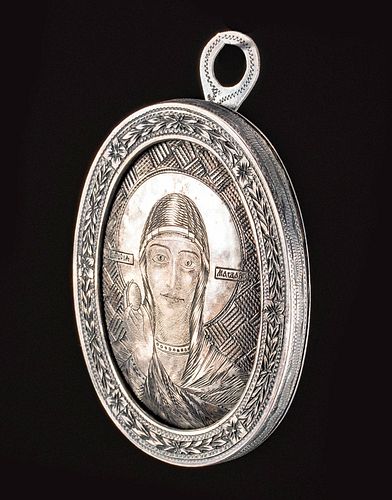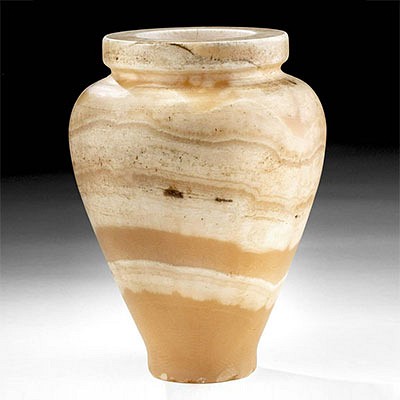1824 Russian Silver Icon Pendant, Mary Magdalene 67.4 g
Lot 165b
About Seller
Artemis Fine Arts
686 S Taylor Ave, Ste 106
Louisville, CO 80027
United States
Selling antiquities, ancient and ethnographic art online since 1993, Artemis Gallery specializes in Classical Antiquities (Egyptian, Greek, Roman, Near Eastern), Asian, Pre-Columbian, African / Tribal / Oceanographic art. Our extensive inventory includes pottery, stone, metal, wood, glass and textil...Read more
Categories
Estimate:
$1,400 - $2,100
Absentee vs Live bid
Two ways to bid:
- Leave a max absentee bid and the platform will bid on your behalf up to your maximum bid during the live auction.
- Bid live during the auction and your bids will be submitted real-time to the auctioneer.
Bid Increments
| Price | Bid Increment |
|---|---|
| $0 | $25 |
| $300 | $50 |
| $1,000 | $100 |
| $2,000 | $250 |
| $5,000 | $500 |
| $10,000 | $1,000 |
| $20,000 | $2,500 |
| $50,000 | $5,000 |
| $100,000 | $10,000 |
| $200,000 | $20,000 |
About Auction
By Artemis Fine Arts
Dec 17, 2020
Set Reminder
2020-12-17 10:00:00
2020-12-17 10:00:00
America/New_York
Bidsquare
Bidsquare : VARIETY SALE | Antiquities & Ethnographic Art
https://www.bidsquare.com/auctions/artemis-gallery/variety-sale-antiquities-ethnographic-art-6207
Featuring classical antiquities, ancient and ethnographic art from cultures encompassing the globe. Egyptian, Greek, Roman, Etruscan, Near Eastern, Asian, Pre-Columbian, Native American, African / Tribal, Oceanic, Spanish Colonial, Russian, Fossils, Fine Art, more! Artemis Fine Arts info@artemisfinearts.com
Featuring classical antiquities, ancient and ethnographic art from cultures encompassing the globe. Egyptian, Greek, Roman, Etruscan, Near Eastern, Asian, Pre-Columbian, Native American, African / Tribal, Oceanic, Spanish Colonial, Russian, Fossils, Fine Art, more! Artemis Fine Arts info@artemisfinearts.com
- Lot Description
Eastern Europe, Russia, ca. 1824. A gorgeous silver icon pendant of ovoid form adorned with niello decoration featuring Mary Magdalene, as indicated by the Cyrillic banners to either side of her. Surrounded by a lovely vegetal border with six quatrefoils, Mary wears a dark veil over a light tunic, decorated with a band of dots at her neck and wrist. The epitome of beauty, her blessed visage glares out at her viewers from sizable, almond-shaped eyes, as her full lips lie closed under her petite nose and straight brow. In the elegantly long fingers of her right hand, she holds an egg; a symbol of the empty tomb of Jesus and his resurrection, as outside the egg appears dormant, but inside it holds new life. Though a patchwork pattern adorns the space around her, her head is crowned by a large halo, which is left blank, allowing the bare lustrous silver to create an ethereal glow, imbuing her with an air of incorporeality. Size: 2.2" W x 3.375" H (5.6 cm x 8.6 cm); quality of silver: 88.65% for tondo, 83% for back, and 90.6% for frame; total weight: 67.4 grams
The periphery of the frame is ornamented with a zig-zag motif. The back not only features a top loop for suspension, but is also inscribed Cyrillic writing, which translates to "Bless and Save" surrounded by an abstract design. Below the writing, one can find Russian silver hallmarks indicating when, where, and who made the piece. The tondo, frame, and backing can be separated, allowing one to store something inside this stunning pendant.
Unlike Western Catholicism, in the Eastern Orthodox Church, Mary Magdalene is regarded as a virtuous woman her entire life, rather than only after she meets Jesus. The egg is also a frequent iconographical characteristic of Mary Magdalene within the Orthodox religion. Not only due its relation to the resurrection of Christ, at which Mary was present, but also because of many legends that have arose involving Mary and an egg. One tale claims that Mary was holding a basket of eggs when she went to visit Jesus’s empty tomb on Easter Sunday. Another, more popular story asserts that, after the death and resurrection of Jesus, Mary used her position to gain an invitation to a banquet hosted by the Roman Emperor Tiberius and when she met him, she held a plain egg in her hand and exclaimed, "Christ is risen!" The Emperor laughed and said that Christ rising from the dead was as likely as the egg in her hand turning red while she held it. Before he finished speaking, the egg in her hand turned a bright red and she continued proclaiming the Gospel to the entire imperial house.
Icons (icon means "image" in Greek) are sacred objects within the Eastern Orthodox Christian tradition. Found in homes as well as churches, these painted images depict holy persons and saints as well as illustrate scenes from the Scriptures. Some icons are encased in precious metal covers (oklads) adorned with pearls and semi-precious stones or glass-fronted wooden cases (kiots). Icons are not worshiped, but are instead venerated for their ability to focus the power of an individual's prayer to God. As such they are truly "windows into heaven."
Provenance: ex Estate of Dr. W.M. Bogdanowicz, Naples, Florida USA
All items legal to buy/sell under U.S. Statute covering cultural patrimony Code 2600, CHAPTER 14, and are guaranteed to be as described or your money back.
A Certificate of Authenticity will accompany all winning bids.
We ship worldwide and handle all shipping in-house for your convenience.
#160759Slight bending to overall form, otherwise intact and excellent. Fabulous patina throughout.Condition
- Shipping Info
-
All shipping is handled in-house for your convenience. Your invoice from Artemis Gallery will include shipping calculation instructions. If in doubt, please inquire BEFORE bidding for estimated shipping costs for individual items.
-
- Buyer's Premium



 EUR
EUR CAD
CAD AUD
AUD GBP
GBP MXN
MXN HKD
HKD CNY
CNY MYR
MYR SEK
SEK SGD
SGD CHF
CHF THB
THB















